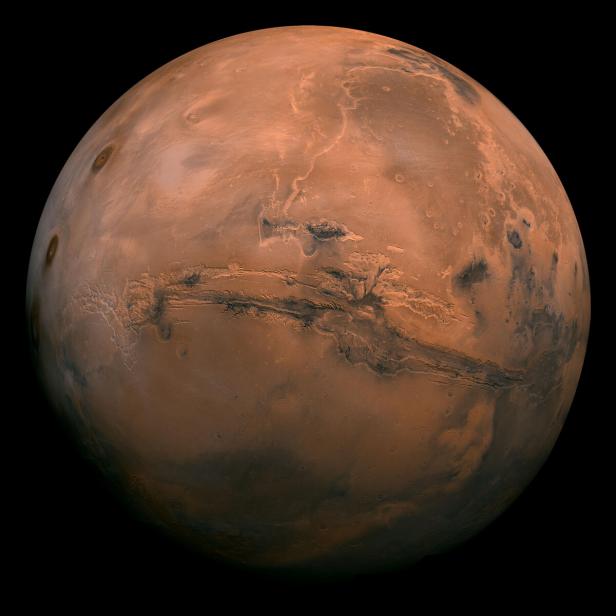
NASA
The 5 Greatest Robotic Space Explorers

Our little silicon friends have been exploring the harshest environments in the universe - space itself - in humanity’s name for decades. And while tales of their robotic exploits could fill an entire book, let’s count down the top five.
5. New Horizons

NASA/Johns Hopkins Applied Physics Laboratory/Southwest Research Institute
The location of the New Horizons Ralph instrument, which detected methane on Pluto, is shown. The inset is a false color image of Pluto and Charon in infrared light; pink indicates methane on Pluto’s surface.
Launched in 2006, New Horizons spent nine and half years in silent reverie as it cruised the outer depths of the solar system, sailing past all four of the giant planets at a speed of 36,000 mph. Finally, in the summer of 2015, it reached its target: Pluto. First discovered in 1930, the little planet-not-a-planet remained as nothing more than a speck of light for decades. Even the powerful Hubble telescope could only reveal a blurry, fuzzy patch of questions. But in the 15 minutes that New Horizons spent taking the portrait of that distant world (you don’t exactly slow down a spacecraft like that), humanity discovered that little Pluto featured giant mountains made of ice, glaciers made frozen nitrogen, and more mysteries for later missions to uncover.
4. Cassini-Huygens

NASA/JPL-Caltech
Illustration of NASA’s Cassini spacecraft during its final plunge into Saturn’s atmosphere on Sept. 15, 2017.
13 years. 13 years. That’s how long NASA’s Cassini spacecraft spent in orbit around the giant ringed world of Saturn. In that time spent in its lonely orbit, astronomers discovered new moons, found just how intricate the rings are, watched in awe and wonder as the planet changed color, and more. A companion lander, the Huygens probe, descended onto the shrouded moon of Titan, a mysterious world with seas of liquid methane and a thick atmosphere nitrogen. When it comes to a combination of longevity and discovery in the interplanetary depths, its hard to beat Cassini.
3. Venera

NASA
Venera 13 was launched on 30 October 1981 and Venera 14 was launched on 4 November 1981. They journeyed to Venus and deposited their landers on 1 March and 5 March 1982, respectively. There were 2 high-energy instruments aboard each spacecraft, one a continuation of the French-Soviet collaboration and one called the "Konus" experiment. These experiments returned data until March 1983.
For over 20 years, the Soviet Union doggedly launched mission after mission to Venus, Earth’s twin sister world. Most of them failed, but it wasn’t the fault of the Soviets. Venus is hands-down one of the nastiest planets in the solar system, which surface pressures over 90 times that of the Earth’s, and temperatures hot enough to melt lead. Of all the Venera missions, ten managed to make it to the surface, giving the Soviets space agency a raft of notable firsts: the first human-made device to enter the atmosphere of another world, the first to make a soft landing on another planet, and the first to return pictures from the surface of another planet. None of the landers managed to last in that hellish environment for more than a couple hours, but without them we would have no idea of the true surface of Venus.
2. Sojourner

NASA/JPL
Lander image of rover near "The Dice" (three small rocks behind the rover) and "Yogi" on sol 22. Sojourner spent 83 days of a planned seven-day mission exploring the Martian terrain, acquiring images, and taking chemical, atmospheric and other measurements.
NASA’s Sojourner, “the little rover that could”, ignited imaginations around the world when it began its tour of Mars in 1997. Just two feet long and weighing 25 pounds, the solar-powered robot was the first wheeled vehicle to traverse another planet. While it only lasted 85 days, the mission proved worthy of its name – Pathfinder – as it proved the technology necessary to send larger, more capable rovers to the Martian surface. These missions are in operation today (with more on the way!) hunting for signs of past life and scoping out possible landing sites for a future human visit.
1. The Voyagers

NASA/JPL
Of course the #1 spot has to go to the Voyagers. Launched in 1977, the twin spacecraft took advantage of a rare alignment of the outer planets to give humanity its first “grand tour” – a serious of close-up pictures of Jupiter, Saturn, Uranus, Neptune, and their moons. Never before had we seen those worlds to that level of detail. And in the case of Uranus and Neptune, The Voyager missions remain our only portrait of them. Both spacecraft are still operational, with Voyager 1 becoming the first human-made object to breach interstellar space in 2012. They are humanity’s ultimate emissary, an artefact of our civilization that will continue to travel the Milky Way galaxy for hundreds of millions of years to come. Even if we never launch another space probe, at least we had the Voyagers.



















